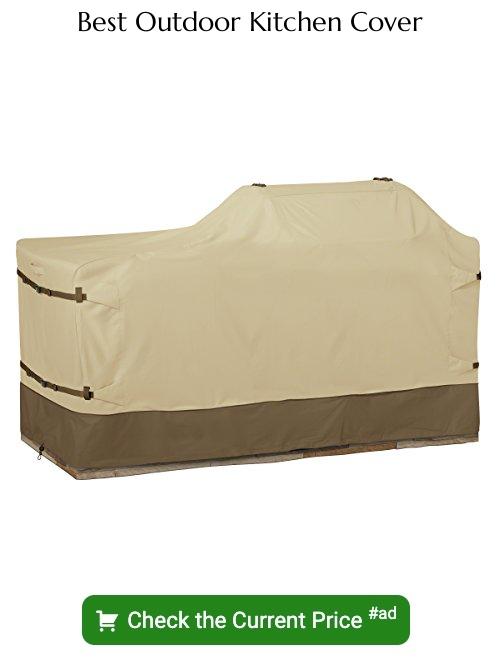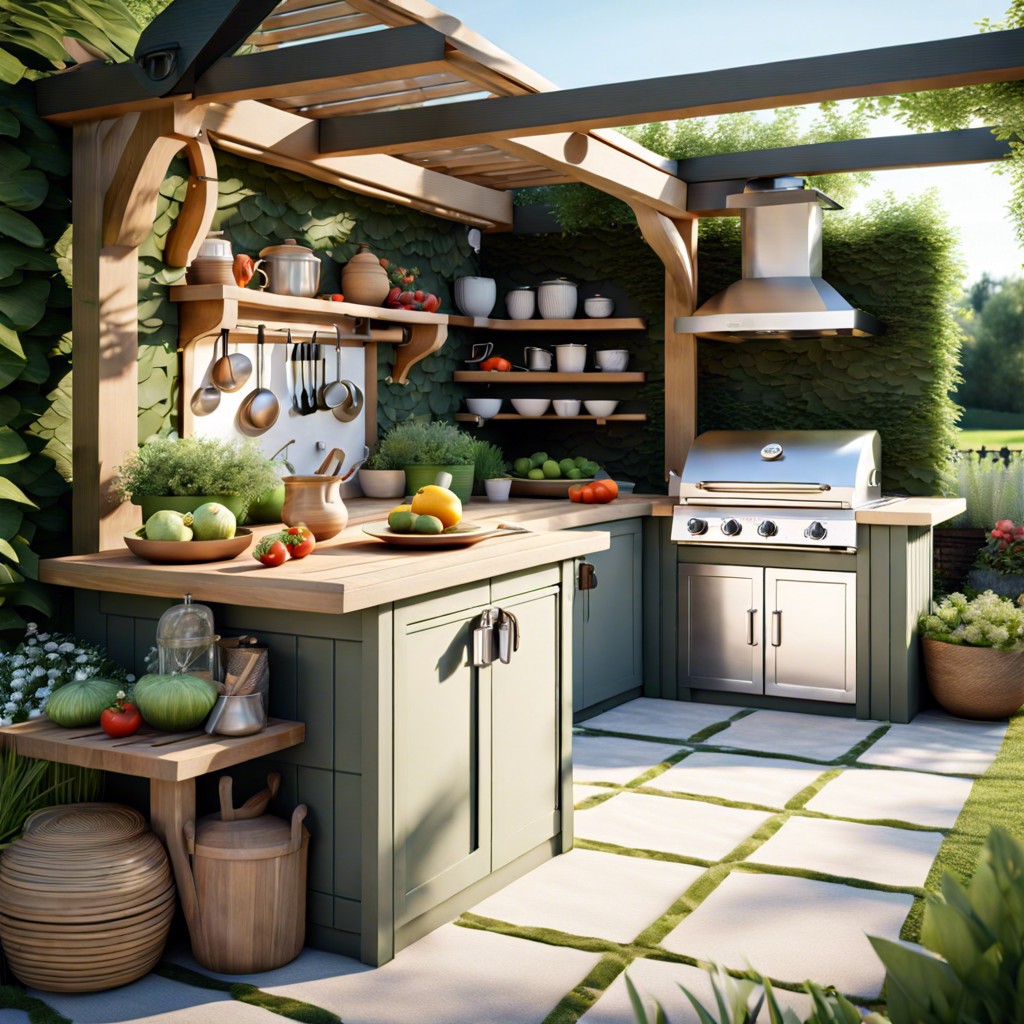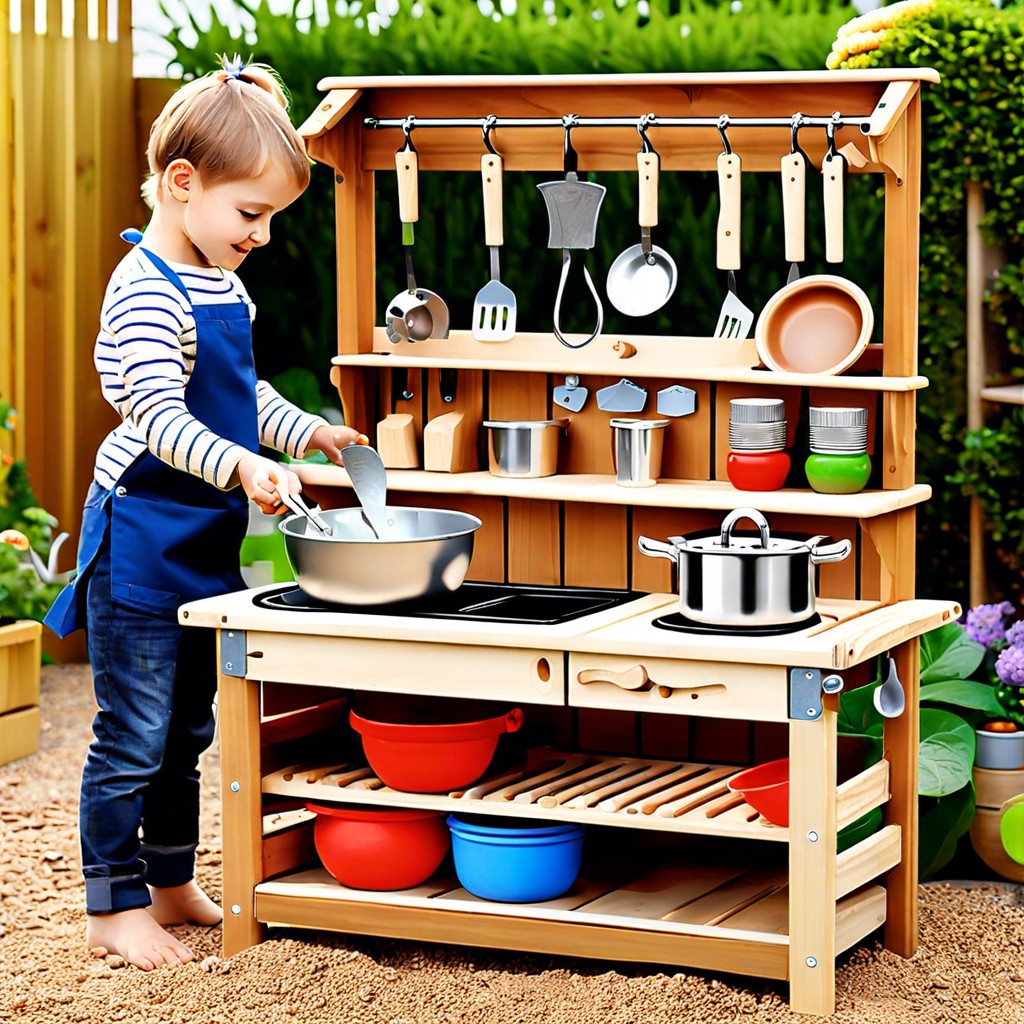Last updated on
Discover the essentials of outdoor kitchen designs, as we delve into whether or not a covering is necessary for your dream alfresco cooking space.
Outdoor kitchens have become increasingly popular in recent years, as homeowners seek to extend their living spaces beyond the walls of their homes. They offer a perfect way to enjoy the great outdoors while cooking and entertaining guests.
However, many homeowners are left wondering whether or not they need to cover their outdoor kitchen. Will it be okay if it’s left exposed to the elements? In this article, we’ll explore the pros and cons of covering an outdoor kitchen so that you can make an informed decision about what’s best for your space.
What's Inside
Importance of Covering an Outdoor Kitchen
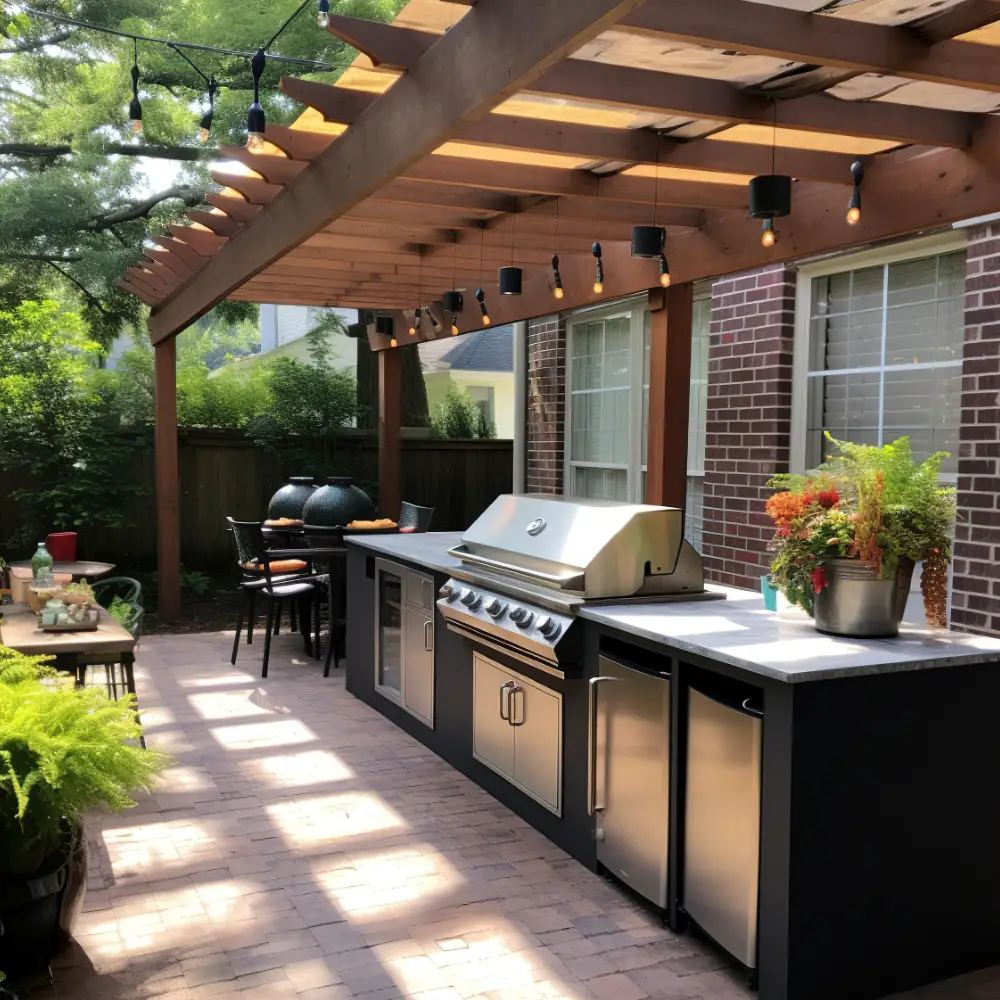
When it comes to designing an outdoor kitchen, one of the most important decisions you’ll make is whether or not to cover it. While some homeowners may prefer the open-air feel of an uncovered space, there are several reasons why covering your outdoor kitchen can be beneficial.
First and foremost, a cover provides protection from the elements. Rain, snow, and extreme heat can all damage your appliances and materials over time if they’re left exposed.
A good quality cover will help prevent this damage by keeping moisture out while also shielding your equipment from direct sunlight.
In addition to protecting against weather-related wear-and-tear on your appliances and surfaces, covering an outdoor kitchen also helps keep pests at bay. Without a roof or other type of overhead protection in place for food preparation areas like grills or countertops where crumbs might accumulate easily attract insects such as ants that could contaminate food items.
Benefits of Covering an Outdoor Kitchen
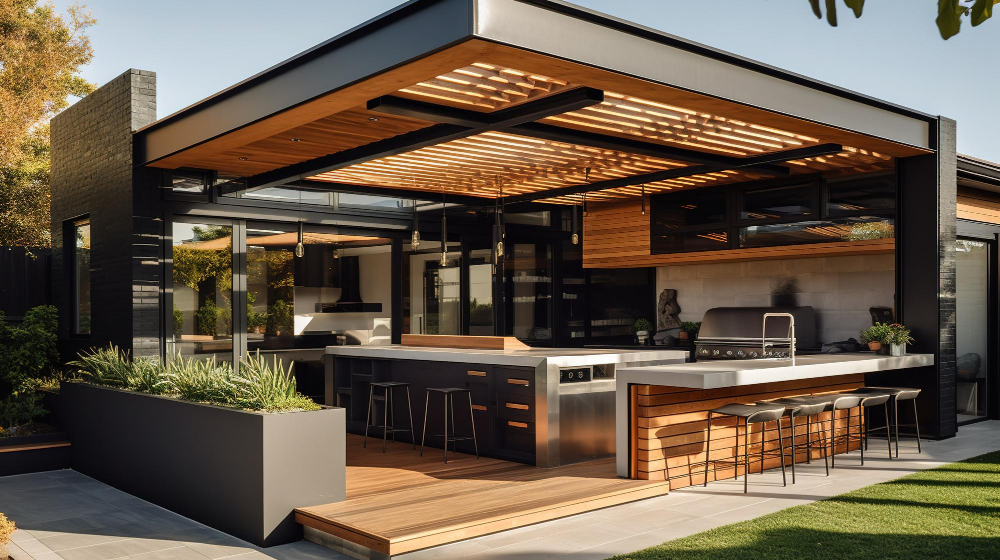
One of the most significant advantages is protection from the elements. A covered outdoor kitchen shields your appliances, countertops, and cooking area from rain, snow, wind-blown debris and harsh sunlight.
This means you can use your space all year round without worrying about damage to equipment or food contamination.
Another benefit of covering an outdoor kitchen is increased comfort for you and your guests while cooking or dining outside. With a cover overhead, you’ll be protected from direct sunlight on hot days while still enjoying fresh air outdoors.
Covering an outdoor kitchen adds value to your home by creating additional living space that can be used for entertaining guests or relaxing with family members in style.
Pros and Cons of Covered Outdoor Kitchens
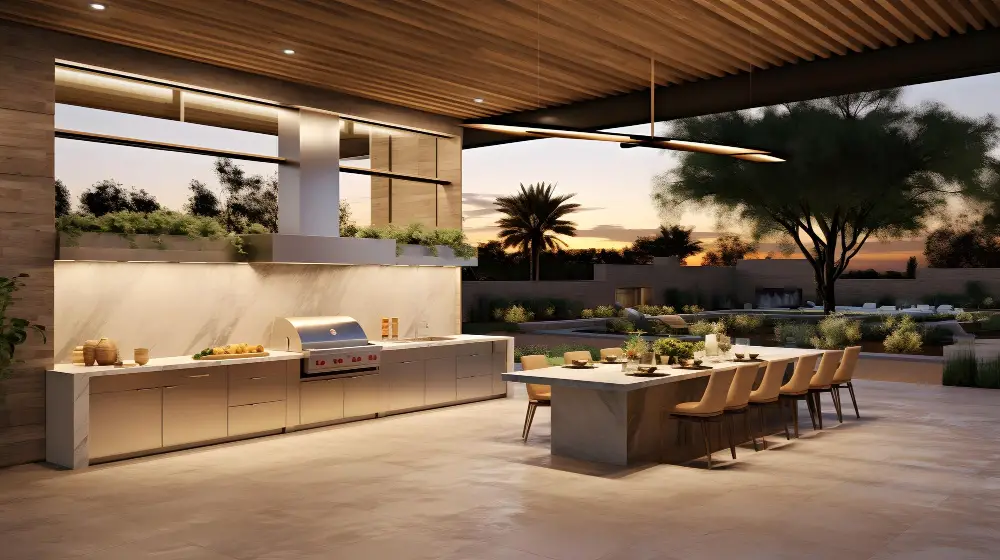
One of the main benefits of covering your outdoor kitchen is that it provides protection from the elements, such as rain, snow, and wind. This means you can use your space all year round without worrying about damage to appliances or furniture.
Another advantage is that a covered outdoor kitchen can add value to your home. It’s an attractive feature for potential buyers who are looking for a functional and stylish living space outside their homes.
However, there are also some downsides to consider when deciding whether or not to cover your outdoor kitchen. For instance, adding a cover may increase the cost of building or renovating an existing structure significantly.
Climate Considerations for Outdoor Kitchens
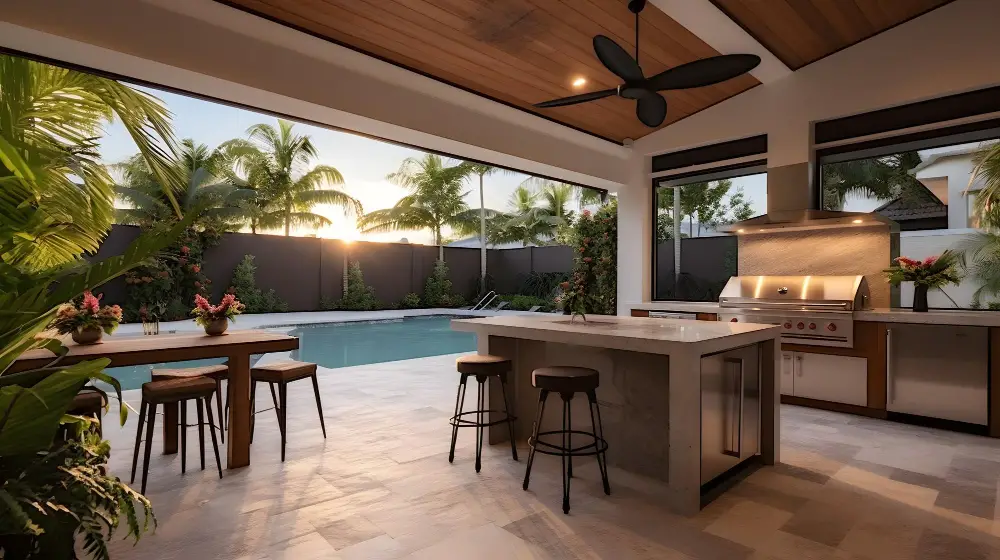
If you reside in an area with frequent rain or snowfall, a covering may be necessary to protect your appliances and cooking surfaces from water damage. Similarly, if you live in a region with high winds or extreme temperatures, such as desert areas where daytime heat can reach over 100 degrees Fahrenheit and nighttime lows can drop below freezing point during winter months; then having some form of protection for your outdoor kitchen is essential.
On the other hand, if you’re lucky enough to live somewhere with mild weather year-round like Southern California where there are only two seasons – summer and spring – then perhaps an uncovered outdoor kitchen would suffice. However even here it’s worth noting that direct sunlight exposure could cause fading on certain materials used for countertops and cabinets.
Factors Affecting the Need for a Cover
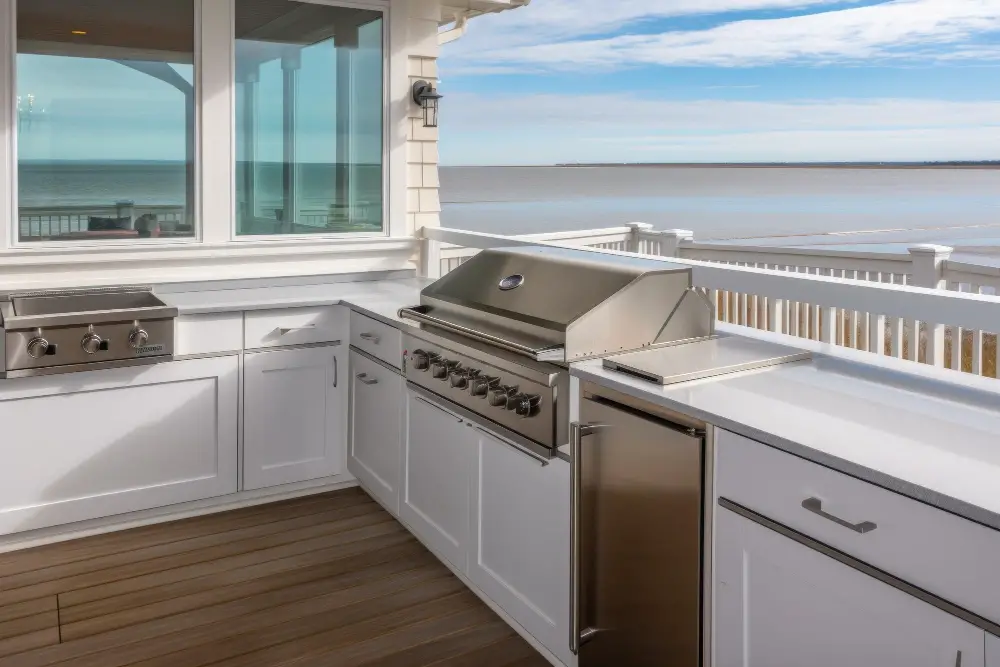
One of the most significant is climate. If you live in an area with harsh weather conditions, such as heavy rain or snowfall, it’s essential to protect your outdoor kitchen from damage caused by exposure to these elements.
Another factor that may affect whether or not you need a cover is the type of materials used in constructing your outdoor kitchen. For example, if you have stainless steel appliances and countertops, they may be more resistant to rust and corrosion than other materials like wood or concrete.
The size of your outdoor kitchen also plays a role in determining whether or not it needs covering. A smaller space may be easier to protect from inclement weather than a larger one because there are fewer areas exposed to potential damage.
Consider how often you plan on using your outdoor kitchen throughout the year when deciding whether or not it needs covering. If you only use it occasionally during warmer months but leave it unused during colder seasons when extreme weather events are more likely – then perhaps investing money into building covers might seem unnecessary for now.
Weather Protection for Outdoor Kitchens
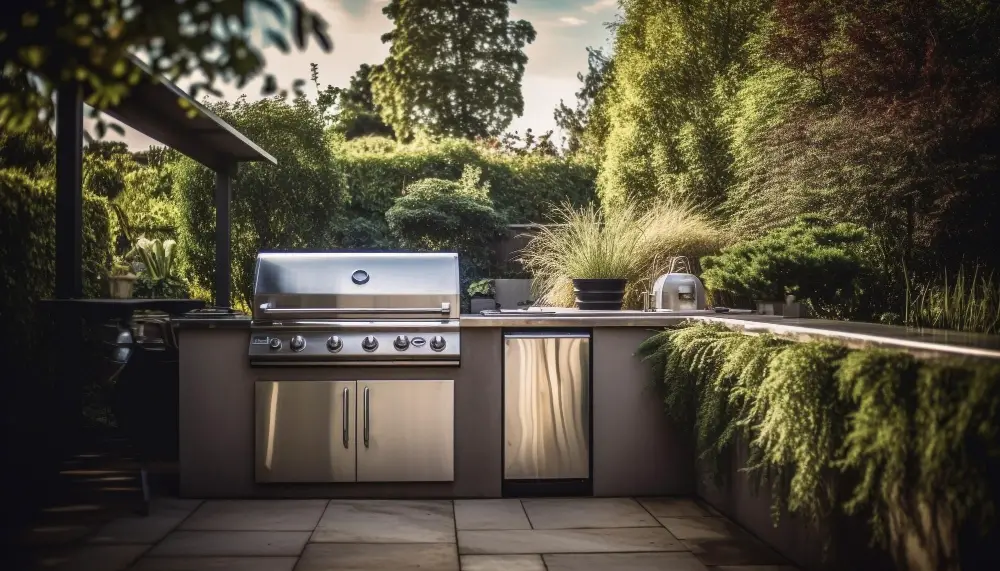
The weather can be unpredictable, and it’s essential to ensure that your cooking space is protected from rain, wind, and other elements. A covered outdoor kitchen provides a sheltered area where you can cook comfortably without worrying about the weather.
When planning for a covered outdoor kitchen, consider the climate in your area. If you live in an area with heavy rainfall or snowfall during certain seasons of the year, then it’s crucial to have adequate coverage over your cooking space.
You may also want to consider adding walls or screens around your covered patio if there are strong winds that could blow debris into your food preparation areas.
Another factor to keep in mind when protecting against inclement weather is ventilation and airflow within the enclosed space. Proper ventilation will help prevent moisture buildup inside cabinets and appliances while ensuring proper air circulation for comfortable cooking conditions.
Safety Concerns and Weather Protection
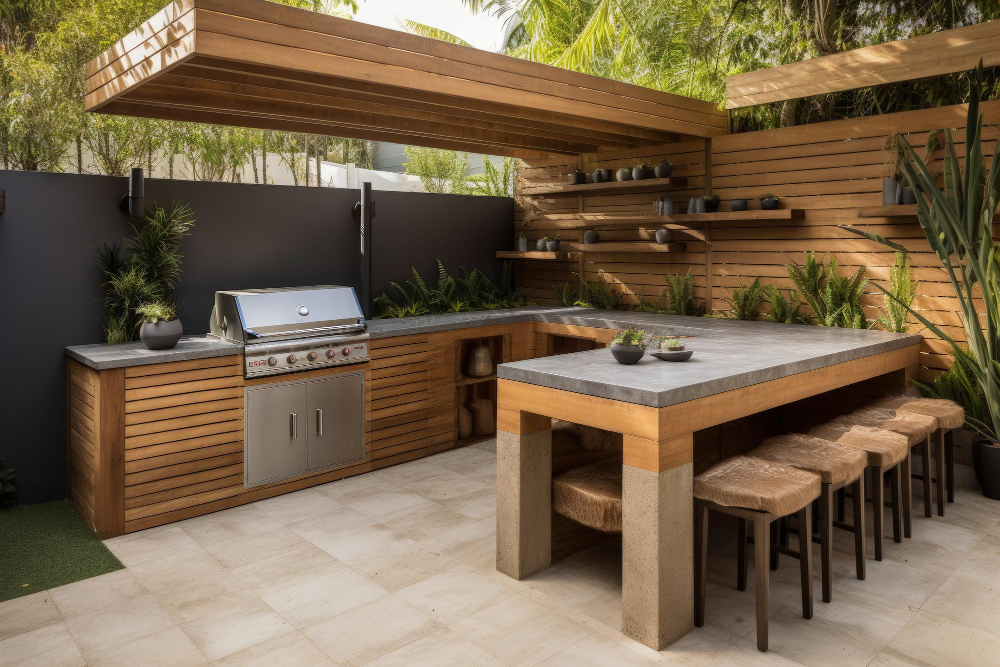
While cooking outdoors can be enjoyable and convenient, it also poses some unique risks that need to be addressed. One of the most significant concerns is weather-related hazards such as lightning strikes or high winds that could cause damage or even injury.
A covered outdoor kitchen provides an added layer of protection against these types of dangers. A sturdy roof will shield you from rain and wind while allowing you to continue cooking in comfort without worrying about getting wet or being blown away by strong gusts.
Covering your outdoor kitchen can help prevent accidents caused by slippery surfaces due to rainwater accumulation on countertops and floors. It also reduces the risk of electrical shock if any appliances are exposed during a storm.
Ventilation and Airflow Considerations
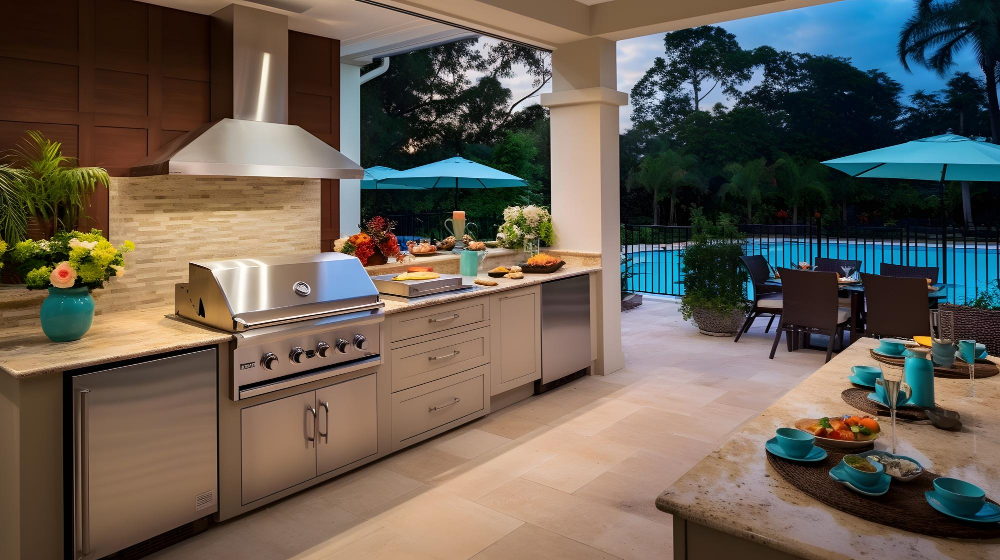
Proper ventilation is essential for any cooking space, indoor or outdoor. Without adequate airflow, smoke and fumes can accumulate in the covered area, making it uncomfortable for you and your guests.
If you plan on installing a grill in your outdoor kitchen that produces a lot of smoke when cooking meats or vegetables with high-fat content like burgers or bacon-wrapped asparagus spears; then covering the area may be necessary. However, if you’re only planning on using an electric grill that doesn’t produce much smoke at all – then covering might not be needed.
In addition to proper ventilation being crucial for comfort reasons; it’s also vital from a safety standpoint. A lack of proper air circulation could lead to carbon monoxide poisoning which can cause headaches dizziness nausea vomiting confusion weakness chest pain shortness of breath seizures coma even death.
Material Options for Outdoor Kitchen Covers
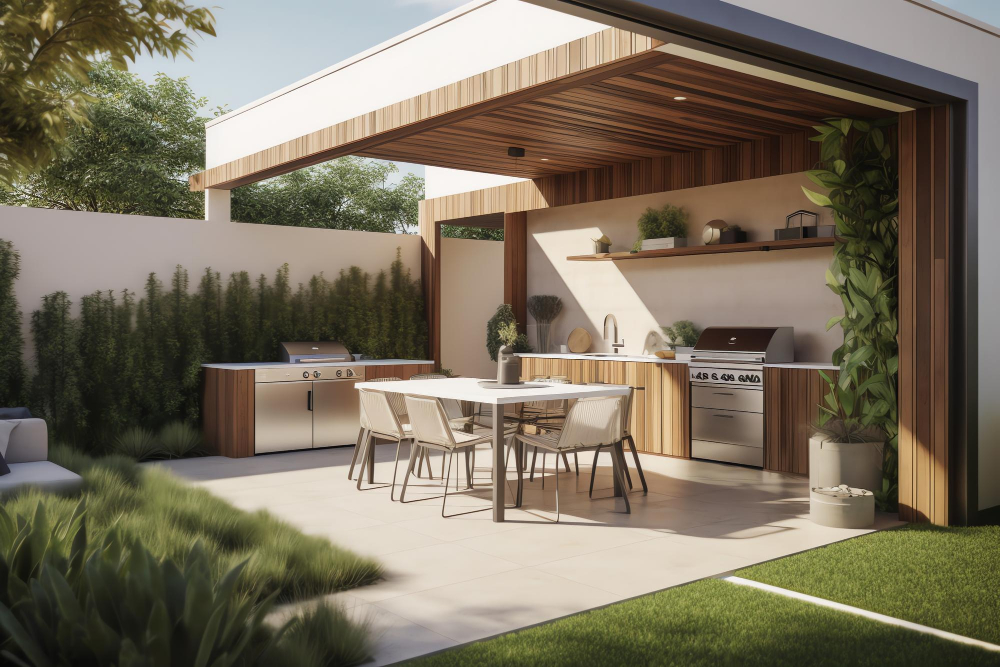
The choice of material will depend on various factors such as the climate in your area, the design style you want to achieve, and your budget.
One popular option for outdoor kitchen covers is wood. Wood offers a natural look that blends well with most landscapes and can be stained or painted to match any color scheme.
However, wood requires regular maintenance and may not be suitable for areas with high humidity or extreme weather conditions.
Another option is aluminum patio covers which offer durability against harsh weather conditions while providing excellent ventilation due to their open lattice design. They come in different colors and styles that can complement any home’s exterior decor.
For those who prefer a more modern look, polycarbonate panels are an excellent choice as they provide ample protection from rain while allowing natural light into the space below them.
Lastly, fabric awnings made of acrylic materials offer flexibility when it comes to installation since they can easily attach onto existing structures like pergolas or patios without requiring additional support beams. They also come in various colors making them perfect for adding some personality into your outdoor living space!
Types of Outdoor Kitchen Covers
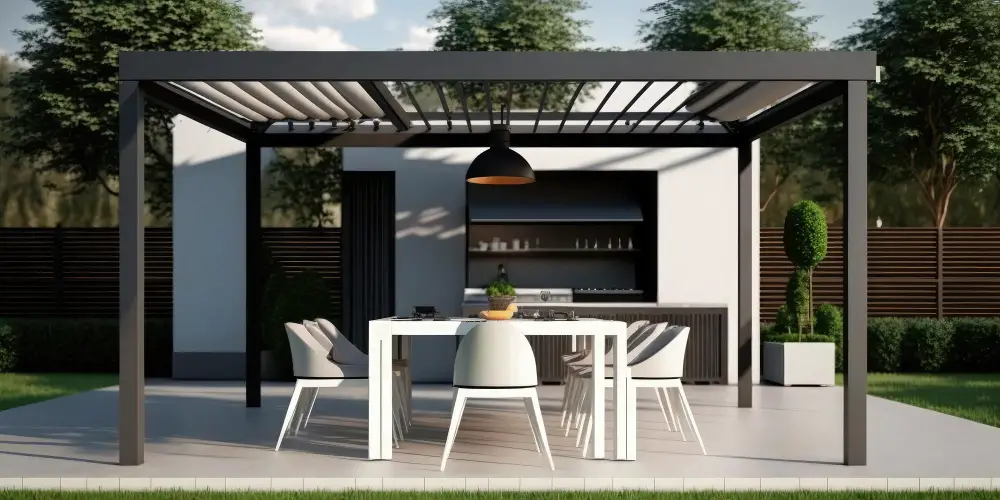
The type of cover you choose will depend on various factors such as the climate in your area, the size and layout of your outdoor kitchen, and personal preferences.
One popular option is a pergola or trellis-style cover. These structures provide partial shade while still allowing for plenty of airflow and natural light.
They can be made from wood or metal materials and can be customized to fit any design style.
Another option is a retractable awning that can be extended when needed but retracted when not in use. This type of cover provides flexibility in terms of how much shade you want at any given time.
For those who prefer full coverage, there are solid roof covers made from materials like aluminum or polycarbonate panels that offer complete protection against rain, snow, and harsh sunlight.
It’s important to note that whatever type of cover you choose should also consider ventilation needs for cooking appliances like grills so they don’t overheat during use.
Permanent Vs. Temporary Covers
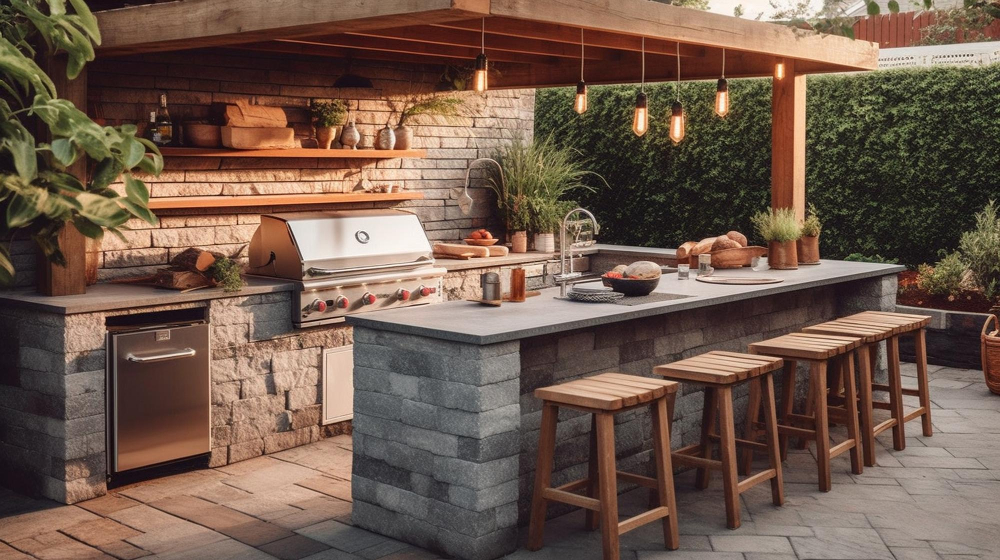
Permanent covers are typically made of durable materials such as wood, metal or stone and are built into the design of the outdoor kitchen. They provide a long-lasting solution that can withstand harsh weather conditions and offer year-round protection for your cooking space.
On the other hand, temporary covers include umbrellas, retractable awnings or shade sails that can be easily installed and removed as needed. These types of covers offer flexibility in terms of adjusting to changing weather patterns but may not provide adequate protection during extreme weather events.
The decision between permanent vs. Temporary coverings will depend on several factors including budget constraints, personal preferences for style and functionality as well as local building codes which may dictate what type of structure is allowed in your area.
Ultimately both options have their advantages depending on individual needs; however investing in a high-quality permanent cover could save you money over time by reducing maintenance costs associated with replacing worn-out temporary solutions every few years.
Design Styles for Outdoor Kitchen Protection
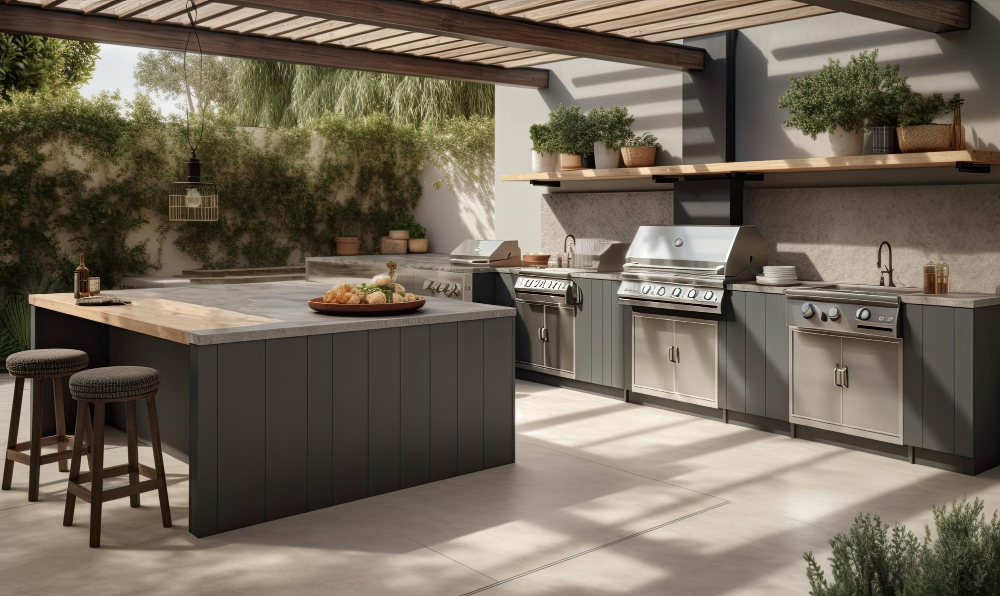
The design style you choose will depend on various factors such as climate, budget, and personal preference.
One popular option is a pergola-style cover that provides partial shade while allowing airflow. This type of cover can be made from wood or metal and can be customized to fit any size or shape of the outdoor kitchen area.
Another option is a solid roof structure that offers complete protection against rain and sun exposure. These structures are typically more expensive than pergolas but provide better weather protection for your appliances and furniture.
For those who want maximum flexibility in their outdoor cooking space, retractable awnings offer an excellent solution. They allow you to adjust the amount of sunlight entering your space depending on the time of day or weather conditions.
Aesthetics and Design Options for Covered Kitchens
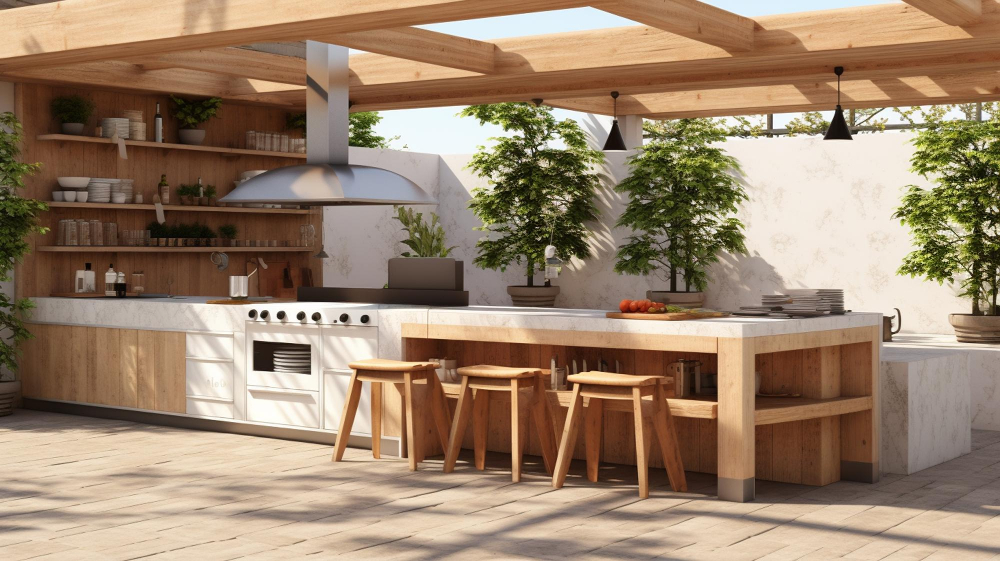
A well-designed cover can add an extra layer of style and sophistication to your outdoor area while providing protection from the elements.
One popular design option is to match the materials used in your home’s exterior or patio flooring. This creates a cohesive look that blends seamlessly with the rest of your property.
For example, if you have a brick house, consider using brick veneer on your outdoor kitchen cover.
Another design consideration is lighting. Adding lights under or around the cover not only provides visibility during nighttime cooking but also adds ambiance and warmth to any gathering.
Don’t forget about landscaping! Incorporating plants or flowers around the perimeter of your covered kitchen can soften its appearance while adding color and texture.
Cost of Covering an Outdoor Kitchen

The price of adding a cover will depend on various factors such as the size of your outdoor kitchen, the type and quality of materials used for construction, and whether you opt for permanent or temporary covers.
Permanent covers are typically more expensive than temporary ones because they require professional installation and may involve additional structural work. On average, homeowners can expect to spend anywhere from $5000-$10,000 or more on a permanent cover depending on their specific needs.
Temporary covers like umbrellas or retractable awnings are less expensive but may not provide adequate protection against harsh weather conditions. They also tend to have shorter lifespans compared to permanent structures.
It’s essential to keep in mind that while covering an outdoor kitchen does come with added costs; it can save you money in the long run by protecting your appliances from damage caused by exposure elements like rainwater and UV rays. Covered kitchens offer extended use throughout different seasons without worrying about extreme temperatures affecting cooking conditions.
Cost Implications of Adding a Cover

The price of covering an outdoor kitchen can vary depending on several factors such as the size of the space, materials used for construction, and design style.
A permanent structure like a pergola or gazebo will typically be more expensive than temporary covers like umbrellas or retractable awnings. However, they offer long-term protection and add value to your property.
Another cost implication is maintenance expenses associated with covered spaces. Permanent structures may require regular upkeep such as painting or staining while temporary covers may need replacement after some time.
It’s essential that you set a budget before embarking on any project so that you don’t overspend beyond what you can afford comfortably. You should also research different options available in the market and compare prices from various suppliers before making any purchase decisions.
Choosing the Right Outdoor Kitchen Layout
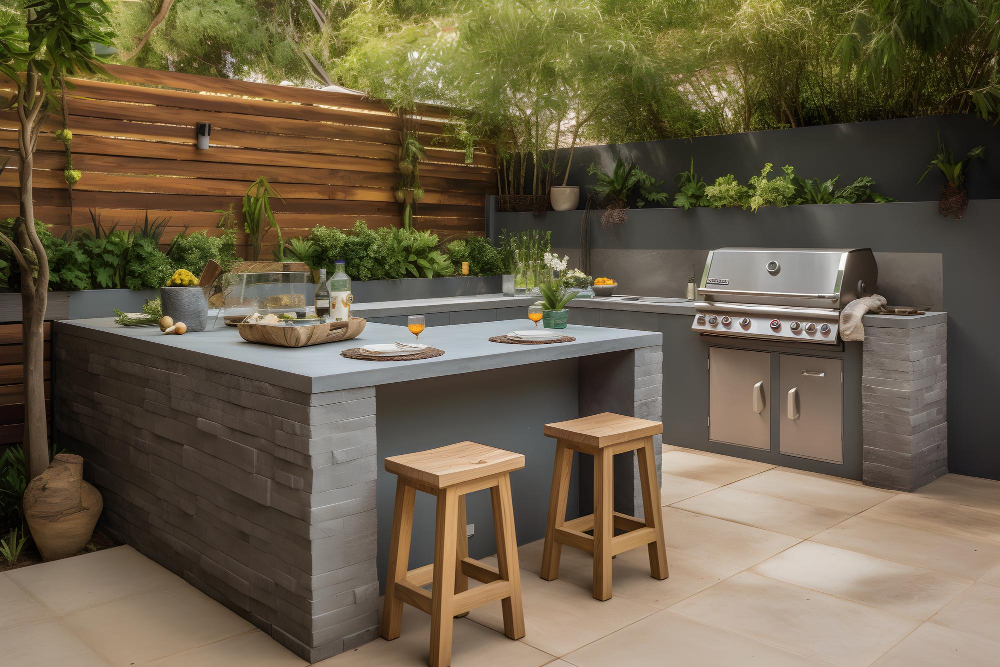
The layout you choose will depend on several factors such as the size of your space, how often you entertain guests and what type of cooking equipment you plan to use. There are various layouts available for outdoor kitchens including L-shaped, U-shaped or straight-line designs.
L-Shaped Layout: This design works well in smaller spaces and provides ample counter space for food preparation. It also allows for a separate area dedicated to grilling.
U-Shaped Layout: This design is ideal if you have a larger space and want more storage options. It offers plenty of counter space while still providing enough room for multiple cooks.
Straight-Line Layout: If simplicity is what you’re after, then this layout may be perfect for your needs. With all appliances lined up in one row against a wall or fence line, it’s easy to access everything without having to move around too much.
Enhancing Functionality With a Covered Kitchen
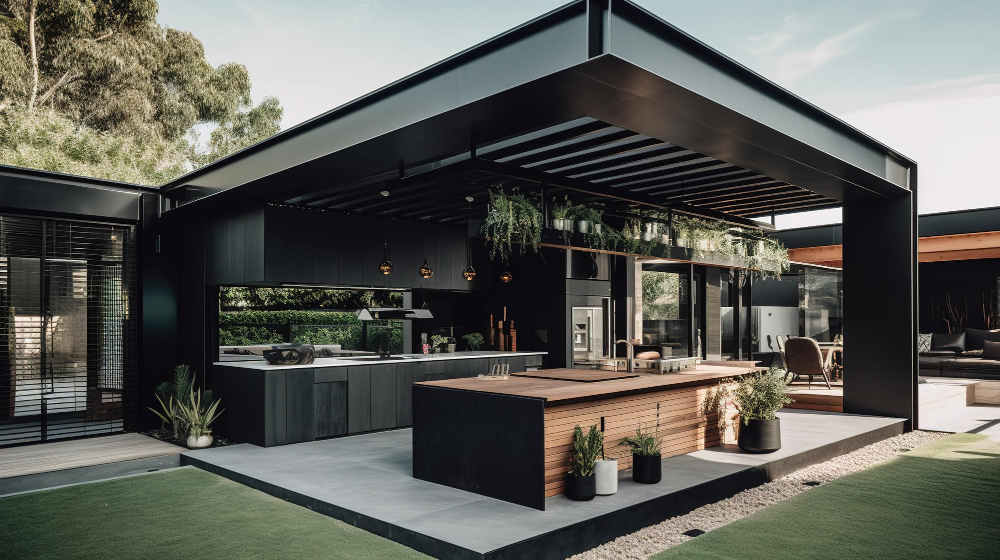
For starters, it provides a sheltered area where you can cook and entertain guests regardless of the weather conditions. This means that you don’t have to worry about rain or excessive heat ruining your plans for an outdoor barbecue party.
A covered kitchen allows for more storage options and appliances that may not be suitable for uncovered spaces. You could install cabinets, refrigerators, sinks and other amenities without worrying about them getting damaged by exposure to harsh elements.
Moreover, covering your outdoor kitchen also adds privacy to your backyard space while creating an intimate atmosphere perfect for entertaining family members or close friends.
Durability and Maintenance of Covered Spaces
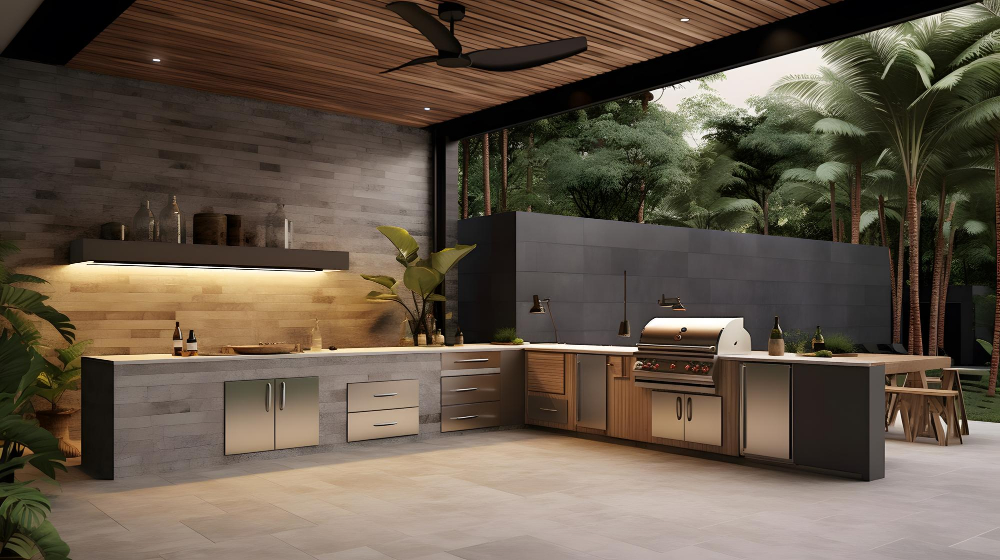
A covered outdoor kitchen can provide protection from the elements, but it’s important to choose materials that can withstand exposure over time. For example, if you live in an area with harsh weather conditions such as heavy rain or snowfall, a durable cover made of metal or high-quality fabric may be necessary.
Regular maintenance is also crucial for keeping your covered outdoor kitchen in top condition. This includes cleaning the cover regularly and inspecting it for any signs of wear and tear.
You’ll want to ensure that all appliances are properly maintained so they continue functioning optimally.
Outdoor Kitchen Maintenance Advantages
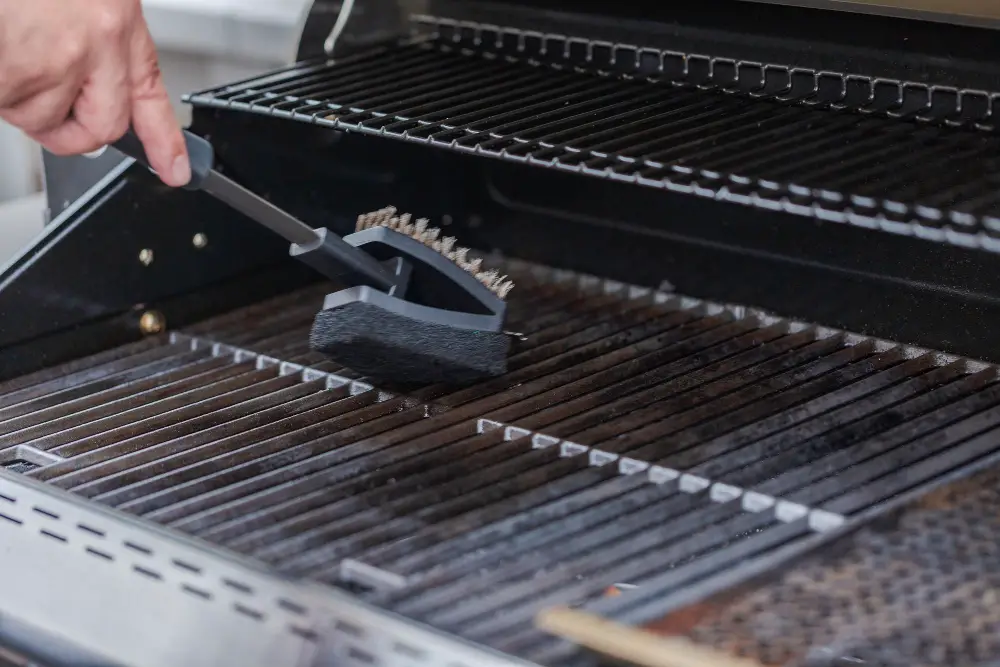
Regular cleaning and upkeep can help extend the life of your appliances, furniture, and other components. One significant advantage of covering your outdoor kitchen is that it provides additional protection from the elements, which can reduce wear and tear on your equipment.
With proper care, you can keep your grill grates clean to prevent rusting or corrosion caused by moisture exposure. You should also regularly check for any signs of damage to electrical wiring or gas lines that could pose safety hazards if left unchecked.
In addition to protecting against weather-related damage, covering an outdoor kitchen makes routine maintenance tasks more manageable. For example, cleaning up after a cookout becomes much easier when you have shelter overhead in case it starts raining unexpectedly.
Building Regulations and Local Codes

Depending on where you live, there may be specific requirements that must be met in order to ensure the safety of your space. For example, some areas require a certain amount of clearance between the grill and any combustible materials such as wood or vinyl siding.
It’s essential to research these regulations before beginning construction on your outdoor kitchen so that you can avoid costly mistakes down the line. Failure to comply with local codes could result in fines or even legal action if someone is injured due to non-compliance.
It’s important to consider how covering your outdoor kitchen will affect compliance with these regulations. Some areas may have restrictions on permanent structures like roofs or awnings while others may require them for weather protection purposes.
Before making any decisions about covering your outdoor kitchen, make sure you understand all relevant building codes and consult with a professional if necessary. By doing so, you can ensure that your space is not only beautiful but also safe for everyone who uses it!
FAQ
Does an outdoor sink need to be covered?
Yes, an outdoor sink needs to be covered to protect it from debris and prevent damages to the basin and drain.
Can outdoor kitchens be rained on?
Outdoor kitchens with equipment designed for outdoor use can handle moisture and won’t deteriorate in the rain.
Do I need a roof over my outdoor kitchen?
Yes, you need a roof over your outdoor kitchen as it extends its longevity, provides shelter from the elements, and enhances your outdoor living experience.
What materials are best for weather-resistant outdoor kitchen countertops?
Granite, stainless steel, and concrete are among the best materials for weather-resistant outdoor kitchen countertops.
How can I protect my outdoor kitchen appliances from the elements?
To protect your outdoor kitchen appliances from the elements, invest in durable, weather-resistant covers and proper storage when not in use.
Are there specific design considerations to make when building an uncovered outdoor kitchen?
When building an uncovered outdoor kitchen, specific design considerations include weather-resistant materials, proper ventilation, and functional layout to withstand varying environmental conditions.
